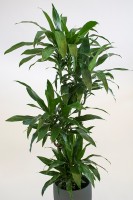
SUPERIOR GROWING CONDITIONS, SUPERIOR PLANTS
Hawaiian tropical plants are known to have a distinctly superior overall look than their Costa Rican or Floridian counterparts and can live up to four times longer. Why? Because Hawaii’s ideal climate and growing conditions naturally produce superior tropical plants with thicker plant caliper, greater fullness, superior color, and consistency in how they look.

HAWAIIAN LAVA ROCK CINDER MEDIA
Hawaiian tropical plants tend to be very difficult to kill because of their stronger and healthier root systems, ultimately requiring less overall maintenance and replacement costs. Plus, most Hawaiian plants’ media consists of lava rock cinder and peat moss.
This mix provides four main benefits:
Better water drainage and aeration to plant root systems due Hawaii’s unique media porosity;
- Minimal media compaction as cinder does not break down;
- Slower decomposition of organic material, leading to a more stable media that is less prone to soil-based insects;
- Less fungus, gnats, and disease.

THINK HEALTHY, THINK HAWAIIAN
According to NASA researchers, Hawaii’s vast array of premium potted foliage are some of the best plants to filter and improve air quality to better your health! These plants include Rhapis Excelsa, Chamaedorea Seifrizii, Dracaena Janet Craig, Ficus “Alii” (“Alii” means “royal” in Hawaiian), Dracaena Fragrans, Dracaena Warneckii, Dracaena Marginata, Norfolk Island Pine, Dendrobium Orchids, Anthurium, and Phalaenopsis Orchids.
Hawaiian Plants for Good Health
(NAPS, April 9, 2018) – According to the Centers for Disease Control and Prevention (CDC), a growing body of scientific evidence suggests the air quality within homes and other buildings can be seriously more polluted than outdoor air, even in the largest and most industrialized cities. But there’s an easy way to protect yourself and your family.
The Problem
Research indicates people spend approximately 90 percent of their time indoors. Thus, for many, the risks to one’s health from exposure to indoor air pollution may be greater than the risk from outdoor air pollution.
In addition, the CDC says, people most exposed to indoor air pollutants are often those most susceptible to their effects. Such groups include the young, the elderly and the chronically ill, especially those suffering from respiratory or cardiovascular diseases.
What To Do
When it comes to keeping your air breathable at home and at work, it really is rocket science. According to NASA researches studying what it would take for humans to travel to other plants, you need at least one indoor plant for every 100 square feet. Plants naturally filter the air of chemicals and other toxins linked to health problems, such as headaches and eye irritation. For example, every 24 hours, plants remove up to 87 percent of indoor volatile organic compounds (VOCs) that otherwise tend to get trapped inside today’s airtight, climate-controlled buildings. NASA’s research found plants purify the trapped air by pulling contaminants into the soil, where microorganism convert VOCs into food for the plant.
One NASA researched, Dr. B.C. Wolverton, even went so far as to list the 50 plants best suited to purify your personal space.
Lucky for lovers of the lush and lovely, 11 of these come from Hawaii. Hawaiian-grown, premium-quality tropical potted foliage and flowers offer an “Aloha Advantage”: They not only provide a beautiful, picturesque piece of paradise, but Hawaiian-grown plants also tend to be very difficult to kill and, therefore, require less overall maintenance and replacement costs. This is probably one of the main reasons designers through the nation choose Hawaiian plants so often.
The Hawaiian Export Nursery Association (HENA) reports the 11 plants that make the health list are Rhapis Excelsa (Lady Palm), Chamaedorea Seifrizii (Bamboo Palm), Dracaena Janet Craig, Ficus “Alii” (“Alii” means “royal” in Hawaiian), Dracaena Fragrans (Corn Plant), Dracaena Warneckii, Dracaena Marginata (Dragon Tree), Norfolk Island Pine, Dendrobium Orchids, Anthuriums, and Phalaenopsis Orchids.
These and other hearty, pretty Hawaiian plants are available at major box stores and retailers such as Home Depot, Lowe’s and Costco, and nearby nurseries and garden centers. To ensure you’re purchasing a Hawaiian-grown plant, look for the unique lava rock soil, which is a main differentiator and reason these plants thrive and grow so healthfully.
Further Flora Research
Houseplants have also been shown to help your health, wealth and happiness in other ways. Researchers at Kansas State University found people in hospital rooms with plants request less pain medication, have lower heart rates and blood pressure, experience less fatigue and anxiety, and were released from the hospital sooner compared to people in rooms without plants.
A Dutch study also discovered adding plants to the workplace decreases fatigue, colds, headaches, coughs, sore throats and flulike symptoms, which was further confirmed by the Agricultural University of Norway. England’s Royal Agricultural University found that students were 70 percent more attentive when there are plants in the classroom.[/mpc_textblock]
